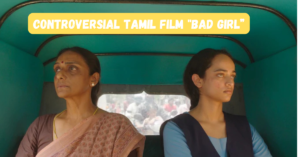Chennai, India – January 27, 2025 – The highly anticipated Tamil film Bad Girl, presented by renowned filmmakers Vetrimaaran and Anurag Kashyap, has found itself at the center of controversy even before its official release. Director Mohan G, known for films like Draupathi and Bakasuran, has openly criticized the movie, accusing it of misrepresenting Brahmins and challenging the filmmakers to depict similar narratives within their own communities.

Mohan G’s Outrage and Criticism
The controversy erupted when Mohan G took to social media to express his strong disapproval of Bad Girl. He particularly criticized the film’s portrayal of a Brahmin girl’s personal life in its teaser. In his statement, he said:
“Portraying a Brahmin girl’s personal life is always a bold and refreshing film for this clan. What more can be expected from Vetrimaaran, Anurag Kashyap & Co… Bashing Brahmin father and mother is old and not trendy. Try with your own caste girls and showcase it to your own family first (sic).”
His remarks have sparked a heated debate among cinephiles, industry professionals, and social commentators, with opinions sharply divided on the issue of artistic freedom versus responsible representation in cinema.
About the Film “Bad Girl”
Bad Girl, directed by debutant filmmaker Varsha Bharath, is a coming-of-age drama that delves into the life of a young woman grappling with societal expectations and her own personal desires. The film promises to explore themes of identity, rebellion, and self-discovery, making it a potentially groundbreaking narrative in Tamil cinema.
Adding to its prestige, Bad Girl has been selected for its world premiere at the International Film Festival Rotterdam (IFFR), an achievement that speaks volumes about its artistic merit and global appeal. The film’s inclusion in an esteemed international film festival highlights its relevance beyond regional cinema and places it on a global platform for critical acclaim.
Freedom of Expression vs. Cultural Sensitivities
The backlash against Bad Girl raises an important question: where should the line be drawn between artistic freedom and cultural sensitivity? Indian cinema has long been a space for storytelling that reflects society’s evolving values, struggles, and aspirations. However, filmmakers frequently face resistance when their narratives challenge established norms or shed light on uncomfortable truths.
While some argue that films like Bad Girl offer a necessary and fresh perspective on contemporary issues, others contend that certain portrayals risk perpetuating stereotypes or offending specific communities. The question remains: should filmmakers prioritize creative expression at the risk of controversy, or should they be more mindful of cultural and social sensitivities?
Social Media Reactions and Industry Responses
Mohan G’s statements have ignited a storm on social media, with reactions coming from various quarters. While some users supported his stance, others criticized his comments as an attempt to police creative storytelling.
- Supporters of Mohan G: Many agreed with his viewpoint, stating that targeting a specific community repeatedly in films can create unnecessary division and foster resentment.
- Critics of Mohan G: Others pointed out that cinema has always been a mirror of society and that no community should be immune to critique or representation in art.
Industry experts, meanwhile, have taken a more balanced stance. A prominent film critic commented:
“Cinema should be a reflection of real life, and storytelling should be unrestricted. However, filmmakers also carry the responsibility of ensuring their narratives do not intentionally or unintentionally harm social harmony.”
Filmmakers’ Stand on the Issue
Neither Vetrimaaran nor Anurag Kashyap has directly responded to the controversy, but sources close to the production team suggest that they stand by their creative choices. Director Varsha Bharath, in an earlier interview, emphasized that Bad Girl is not about vilifying any particular community but about exploring an individual’s journey in a patriarchal society.
“The film is about personal freedom, the struggles of young women in traditional settings, and the choices they make. It is not intended to attack any group but to tell an honest story.”
This statement reflects the film’s broader intent, which goes beyond any single community to address universal themes of identity and self-expression.
A Recurring Debate in Indian Cinema
This is not the first time Indian films have been caught in the crossfire of controversy over cultural representation. Several films in the past, including Jai Bhim, Pariyerum Perumal, and The Great Indian Kitchen, have faced similar criticism for their bold portrayals of societal issues.
In recent years, the rise of politically and socially conscious cinema has led to more discussions about caste, gender, and class disparities in India. While these films have received both appreciation and opposition, they continue to challenge conventional storytelling norms and pave the way for more inclusive narratives.
What Lies Ahead for “Bad Girl”
Despite the backlash, Bad Girl is set to have its premiere at IFFR, and anticipation for its theatrical release remains high. If history is any indication, the controversy may only fuel curiosity and drive more audiences to watch the film.
The film industry and audiences alike must decide whether they want cinema to remain a space for challenging conversations or if they prefer storytelling that avoids uncomfortable truths. Regardless of the stance one takes, there is no denying that films like Bad Girl spark crucial discussions about identity, representation, and artistic liberty.
Final Thoughts
The debate surrounding Bad Girl underscores the evolving landscape of Indian cinema, where filmmakers are increasingly pushing boundaries to tell compelling and socially relevant stories. While some may perceive such narratives as controversial, others see them as necessary reflections of a dynamic society.
As audiences, the choice lies in engaging with these films critically, fostering discussions, and allowing space for diverse perspectives. Whether one agrees with Mohan G’s critique or supports the filmmakers’ vision, one thing is certain—cinema remains one of the most powerful mediums for storytelling and social change.
Visit: 24 Hours Latest News